|
When you watch a really good horse handler working with a horse you should sense a flow as the encounter transcends from the horse handler greeting the animal for the first time to the point where the horse handler accomplishes whatever he or she intended to accomplish. Oftentimes this activity involves a number of specific steps, but the veteran handler intuitively moves from one step to the next, often virtually unnoticed.
Many of us eventually reach a point of intuition where we may not consciously think of each step, although we may have to stop and think when we get to a particularly difficult horse or we just aren't achieving the desired result. Folks who don't handle a lot of different horses might easily get sidetracked, skip a critical element and create a potentially dangerous situation. A few well known clinicians have developed numbered systems that help keep handlers on a logical, linear track. I think these systems are very valuable.
When I used to teach complex skills to fire fighting recruits I often used numbered lists. A rookie fire fighter simply can't fail to "get water" or properly place an aerial ladder in an emergency, no matter how chaotic the event. We had to use easily memorized sequences of actions. Gentling and training horses can turn into chaotic events. Folks handling horses also need established sequences to fall back on to prevent things from getting off center, or to restore control of a situation that is starting to unravel. It's a little late to make corrections when you're being trampled by an uncorked horse or are stuck atop a blind runaway.
In this feature I am presenting a few lists that I consider virtually essential to safe and sane horse gentling and training. These aren't instructions as to how to do all these things, but rather an attempt explain the items on the list in a context that should illustrate their relevance to training, handling and riding horses. Many readers may already do many or all of these things, in which case the use of numbered lists may help you get "grounded" if things start to go awry or help you convey useful information on to others in a form in which they are more likely to remember.
The first list illustrates a logical sequence of activities we often use that was first introduced by, and is still taught by, Pat Parelli.

|
|
THE SEVEN GAMES HORSES PLAY
|
- The Friendly Game.
- The Porcupine Game.
- The Driving Game.
- The Yo-Yo Game.
- The Circling Game.
- The Sideways Game.
- The Squeeze Game.
We first learned the Seven Games back in the 1980s. They weren't called the Seven Games back then. We'd gather for clinics at Pat Parelli's "Foundation Station" in Clements, CA, and he would show us how to become better horsemen. Later, when Pat's following became far too great for everyone to take classes from him personally, he had to create some order in the curriculum so people could understand it from a distance. He broke horse handling down to these Seven Games that are based on the rituals horses play in their own social groups.
- The Friendly Game.
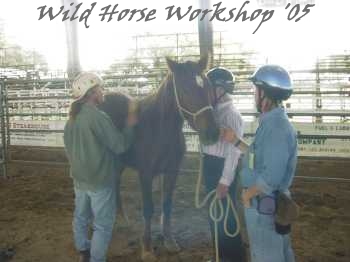 The Friendly Game is more or less an opportunity to introduce ourselves to our horses.
We can establish ourself as not being a predator or threatening, and establish that the
equipment
that we would be using is not threatening. We should be able to touch and/or rub the
horse anywhere without the horse being defensive. We should make note of "safe zones"
where the horse likes to be rubbed or scratched, and go back and forth between "touch
me not" places and those safe zones, gradually desensitizing the scary spots and
retreating regularly to the safe zones to maintain the horse's trust and courage.
The Friendly Game is more or less an opportunity to introduce ourselves to our horses.
We can establish ourself as not being a predator or threatening, and establish that the
equipment
that we would be using is not threatening. We should be able to touch and/or rub the
horse anywhere without the horse being defensive. We should make note of "safe zones"
where the horse likes to be rubbed or scratched, and go back and forth between "touch
me not" places and those safe zones, gradually desensitizing the scary spots and
retreating regularly to the safe zones to maintain the horse's trust and courage.
On a fairly slack lead we'll rub the horse with our hands, crop or stick, flag, halter,
or whatever other equipment we may be using. We have found the Friendly Game to be
particularly beneficial with pasture horses who otherwise don't like to be caught and
with ordinarily edgy horses. The game, however, is beneficial to
all horses. In the pasture we may start the game and get the horse relaxed before
attempting to halter the animal.
- The Porcupine Game.
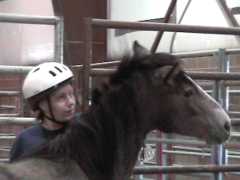 Once the horse is relaxed about our getting into his space, we need to balance the
encounter so that the horse doesn't presume that he can simply invade our space. He
also needs to yield to pressure in order to correctly respond to lead line, rein and
leg aids. We might as well start to develop these responses right here on the ground.
Once the horse is relaxed about our getting into his space, we need to balance the
encounter so that the horse doesn't presume that he can simply invade our space. He
also needs to yield to pressure in order to correctly respond to lead line, rein and
leg aids. We might as well start to develop these responses right here on the ground.
We apply pressure with our fingers or our stick with just enough force to annoy the
horse. If he leans into us we hold steady. If he yields (moves away) we let him
enjoy the benefit of the release from pressure. Once the horse gets the idea, we
can fairly easily shape that behavior into yielding the hindquarters and the forehand
and to simplify backing the horse. Plus, the Porcupine Game allows us to apply an
easy but efficient reminder if the horse starts to invade our space for any reason.
- The Driving Game.
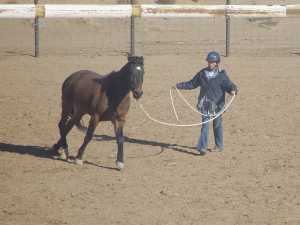 This game is designed to teach the horse to move out when given "implied" pressure.
We ofttimes say we are sending the horse off with our intentions. We want the horse
to recognize and respond to our body language, not aggressive cues or aids. This is
where we "whisper" to the horse. (We want to save "shouting" to those times when
things may be headed into real trouble and we want those "shouts" to be distinctive
from our normal levels of communication.)
This game is designed to teach the horse to move out when given "implied" pressure.
We ofttimes say we are sending the horse off with our intentions. We want the horse
to recognize and respond to our body language, not aggressive cues or aids. This is
where we "whisper" to the horse. (We want to save "shouting" to those times when
things may be headed into real trouble and we want those "shouts" to be distinctive
from our normal levels of communication.)
This game requires some consistency on the part of the handler. For example, if we
want a horse to yield away and move off we will usually wave the horse away with our
hands. If the horse remains stuck, we'll tap with our finger tips. If he is still
stuck we will press harder with our fingers. If he still resists moving we'll slap
the side of his neck with the flat of our hands. All this motion is done with some
rhythm, allowing the
horse a little time to make the correct decision. Eventually the horse gets the idea.
If the handler is consistent in playing this game, the horse will require less pressure
and eventually move off in response to a simple wave of the hand.
(Note: Since we are good horse handlers and we don't pat our horses as a reward since
patting a horse is considered to be annoying by most horses, the horse should realize
that our slaps mean serious business.)
- The Yo-Yo Game.
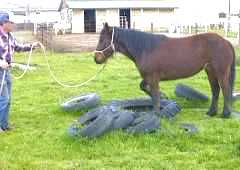 One of the most important behaviors in a horse is to back politely when asked.
Similarly a horse needs to step forward when asked. The Yo-Yo Game accomplishes both
objectives.
One of the most important behaviors in a horse is to back politely when asked.
Similarly a horse needs to step forward when asked. The Yo-Yo Game accomplishes both
objectives.
The objective of the Yo-Yo game is for the horse to back quietly in a straight line,
stop, and then return to us when asked. The challenge, until horse and handler are
communicating well, is to back the horse in a straight line and not inadvertently
encourage him to roll away but maintain focus on the handler with both eyes.
- The Circling Game.
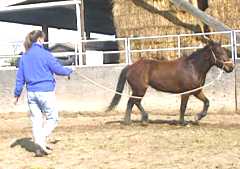 Whether on a lead or at liberty in the round pen, circling can either be very beneficial
to a horse or it can generate a host of undesirable behaviors. For example, many horses
that are constantly mindlessly longed develop a habit of surging forward under pressure.
Over the years we've encountered countless people asking how to solve problems with
frantic, bolting horses. Many are puzzled because they religiously longe their horses
a half hour a day or more, and in doing so may, unfortunately, be teaching the horse
that when the human brings his or her attention to bear on the horse, the horse had
better run.
Whether on a lead or at liberty in the round pen, circling can either be very beneficial
to a horse or it can generate a host of undesirable behaviors. For example, many horses
that are constantly mindlessly longed develop a habit of surging forward under pressure.
Over the years we've encountered countless people asking how to solve problems with
frantic, bolting horses. Many are puzzled because they religiously longe their horses
a half hour a day or more, and in doing so may, unfortunately, be teaching the horse
that when the human brings his or her attention to bear on the horse, the horse had
better run.
And then we have the rearers and buckers who used to run but their riders got bigger,
meaner bits, and martingales or tie downs, so now their behavior is getting
progressively worse. (Does anyone think that perhaps these
horses' handlers may have just needed some fresh perspective?)
The Circling Game is designed to derive the benefits of round work and minimize the
pitfalls. Parelli breaks circling down into three elements.
The game's first element is called the "Send." The idea is to point the horse's nose
in the direction we want him to go and send him off.
The second element is called the "Allow." Here we allow the horse to take
responsibility to maintain his gait out in the circle. We're only going to bug him
if he starts to fall off his gait or he loses track of what he's supposed to be doing.
If we "allow" the horse to get right and not "nag" him into maintaining speed and
direction motion, the horse is more likely
to keep his mind on his business and take responsibility for doing what is asked.
The third element is called the "Bring Back." Before the horse drifts into just
doing mind numbing circles, we're going to throw in some changes. The basic change
involves tugging on the line, or using body language if the horse at liberty, in
order to ask the horse to come in. The "Bring Back" should be set up to cause the
horse to disengage his hindquarters, a critical response to have embedded in the
hose before getting him under saddle.
Parelli currently teaches doing the Circle Game" without the handler moving his feet.
For various reasons, including safety and reminding the horse that we are animate
objects, not Maypoles, we prefer to move just a little bit in the center of
the circle while the horse moves on the line or at liberty.
(Our knees aren't locked, we're more able to move if needed and horses
track moving objects better than fixed objects. Plus we like our horses to think
that we're more athletic than they are and can keep up with them no matter how fast
they move.) We think the critical point here is for the handler to stay in the center
of the circle and to not be out longeing with the horse, or in worst case situations,
fall prey to the game where the horse actually starts longeing the handler!
- The Sideways Game.
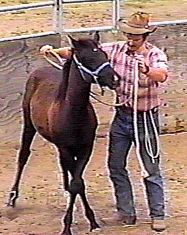 This is a tough game unless the handler thinks things through and stays focused.
This is a tough game unless the handler thinks things through and stays focused.
The objective here is to get the horse to move sideways by applying pressure towards
the head and neck as well as towards the hip. Horses can do this, as anyone atop a
badly shying horse will testify. They just have to be motivated to move sideways
as a result of our cues and aids. In a nutshell, application of some of the previously
mentioned games, such as the porcupine game, will generate sideways movement. In our
experience the Sideways Game is a game where one really has to reward the slightest
try for most horses to not get frustrated.
Horses typically have an easy direction and a tough direction. An important objective
is to get the horse as handy in his difficult direction as he is in his easier
direction.
- The Squeeze Game.
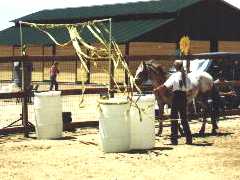 This is a game where your horse gets confident moving through progressively smaller
spaces, which can be beneficial when one needs to send a horse through small gates,
stall doors or into trailers that have individual doors or a vertical center bar.
This is a game where your horse gets confident moving through progressively smaller
spaces, which can be beneficial when one needs to send a horse through small gates,
stall doors or into trailers that have individual doors or a vertical center bar.
Proficiency in earlier games that establish forward motion and changes of direction
is necessary to get the Squeeze Game to work well. Various safe objects, as well
as the handler and the arena rail, can be used to define the sides of the "squeeze."
(We like to have our horses
proficient in a move we call a "Bow Tie," or longeing back and forth with changes of
direction each time the horse reaches the end of the rope, forming a rather narrow,
sideways figure eight or, as we call it, a bow tie. This way we can send the horse
back and forth as the squeeze area gets tighter and he processes the puzzle from
both sides and opposite directions. However horses can be longed through squeezes.)
We start this game out simple with large openings for the horse to pass through, then
make the game progressively more challenging.
Please note that the intent of this feature is to illustrate the purposes and usefulness of ordered lists that we like for gentling and training horses. It is not our intention, nor do we have the space, to identify all of the potential techniques that can make these games successful or to try to teach various nuances involved. For more complete information on the Seven Games Horses Play and related training concepts, please visit www.parelli.com. "Parelli" is a registered trademark of Parelli Natural Horsemanship, Inc., Pagosa Springs, CO.
This feature continues to Frank Bell's "Seven Step Safety System."
|



 The Friendly Game is more or less an opportunity to introduce ourselves to our horses.
We can establish ourself as not being a predator or threatening, and establish that the
equipment
that we would be using is not threatening. We should be able to touch and/or rub the
horse anywhere without the horse being defensive. We should make note of "safe zones"
where the horse likes to be rubbed or scratched, and go back and forth between "touch
me not" places and those safe zones, gradually desensitizing the scary spots and
retreating regularly to the safe zones to maintain the horse's trust and courage.
The Friendly Game is more or less an opportunity to introduce ourselves to our horses.
We can establish ourself as not being a predator or threatening, and establish that the
equipment
that we would be using is not threatening. We should be able to touch and/or rub the
horse anywhere without the horse being defensive. We should make note of "safe zones"
where the horse likes to be rubbed or scratched, and go back and forth between "touch
me not" places and those safe zones, gradually desensitizing the scary spots and
retreating regularly to the safe zones to maintain the horse's trust and courage.
 Once the horse is relaxed about our getting into his space, we need to balance the
encounter so that the horse doesn't presume that he can simply invade our space. He
also needs to yield to pressure in order to correctly respond to lead line, rein and
leg aids. We might as well start to develop these responses right here on the ground.
Once the horse is relaxed about our getting into his space, we need to balance the
encounter so that the horse doesn't presume that he can simply invade our space. He
also needs to yield to pressure in order to correctly respond to lead line, rein and
leg aids. We might as well start to develop these responses right here on the ground.
 This game is designed to teach the horse to move out when given "implied" pressure.
We ofttimes say we are sending the horse off with our intentions. We want the horse
to recognize and respond to our body language, not aggressive cues or aids. This is
where we "whisper" to the horse. (We want to save "shouting" to those times when
things may be headed into real trouble and we want those "shouts" to be distinctive
from our normal levels of communication.)
This game is designed to teach the horse to move out when given "implied" pressure.
We ofttimes say we are sending the horse off with our intentions. We want the horse
to recognize and respond to our body language, not aggressive cues or aids. This is
where we "whisper" to the horse. (We want to save "shouting" to those times when
things may be headed into real trouble and we want those "shouts" to be distinctive
from our normal levels of communication.)
 One of the most important behaviors in a horse is to back politely when asked.
Similarly a horse needs to step forward when asked. The Yo-Yo Game accomplishes both
objectives.
One of the most important behaviors in a horse is to back politely when asked.
Similarly a horse needs to step forward when asked. The Yo-Yo Game accomplishes both
objectives.
 Whether on a lead or at liberty in the round pen, circling can either be very beneficial
to a horse or it can generate a host of undesirable behaviors. For example, many horses
that are constantly mindlessly longed develop a habit of surging forward under pressure.
Over the years we've encountered countless people asking how to solve problems with
frantic, bolting horses. Many are puzzled because they religiously longe their horses
a half hour a day or more, and in doing so may, unfortunately, be teaching the horse
that when the human brings his or her attention to bear on the horse, the horse had
better run.
Whether on a lead or at liberty in the round pen, circling can either be very beneficial
to a horse or it can generate a host of undesirable behaviors. For example, many horses
that are constantly mindlessly longed develop a habit of surging forward under pressure.
Over the years we've encountered countless people asking how to solve problems with
frantic, bolting horses. Many are puzzled because they religiously longe their horses
a half hour a day or more, and in doing so may, unfortunately, be teaching the horse
that when the human brings his or her attention to bear on the horse, the horse had
better run.
 This is a tough game unless the handler thinks things through and stays focused.
This is a tough game unless the handler thinks things through and stays focused.
 This is a game where your horse gets confident moving through progressively smaller
spaces, which can be beneficial when one needs to send a horse through small gates,
stall doors or into trailers that have individual doors or a vertical center bar.
This is a game where your horse gets confident moving through progressively smaller
spaces, which can be beneficial when one needs to send a horse through small gates,
stall doors or into trailers that have individual doors or a vertical center bar.